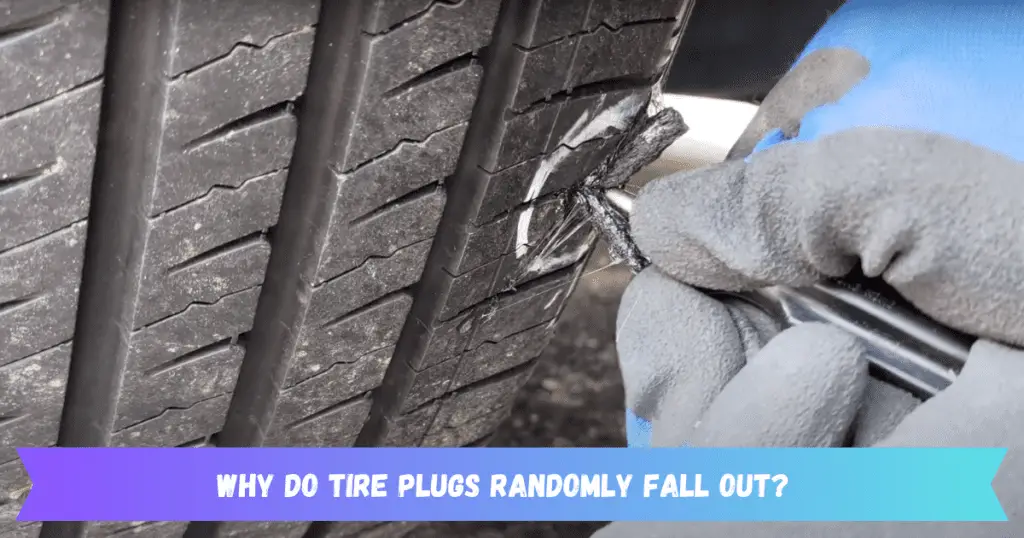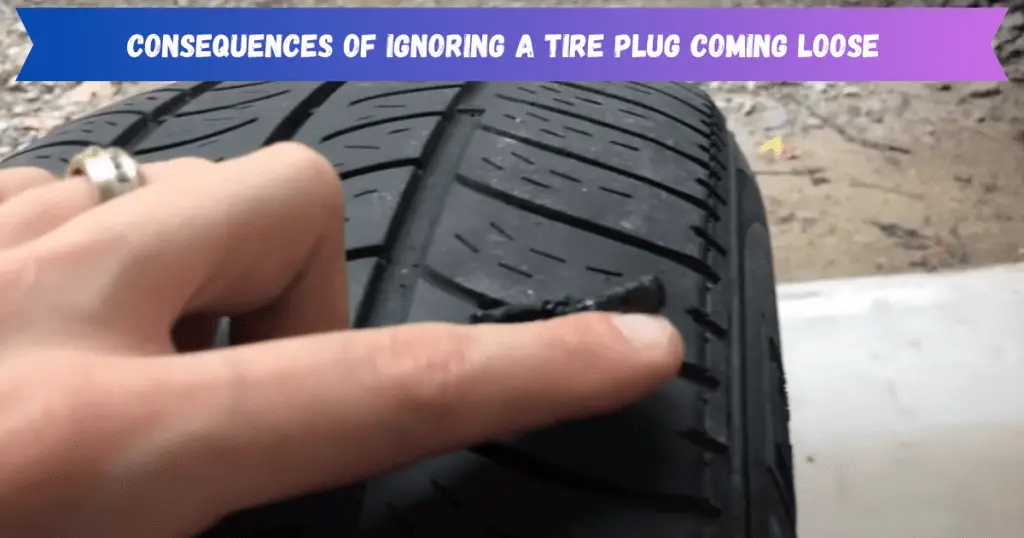We won’t sugarcoat the truth – slipping tire plugs can deflate your whole day. Let’s re-inflate your comprehension of why plugs pop out to keep your tires properly patched and happily attached!
Why Do Tire Plugs Randomly Fall Out?

Like a receding hairline, there are a few reasons tire puncture plugs can loosen and fail, including:
Incorrect Plug Style
Using the wrong plug type for the puncture and tire construction risks eventually working free. Different tools and plugs exist for a reason.
Shoddy Installation
Improper plug insertion technique by amateurs leads to inadequate adhesion and sealing that ejects plugs when stressed.
Excessive Tire Flexing
Insufficient plug friction grip combined with overly soft tires and wheels allows flexing forces to push out plugs over time.
Repeated High Speeds
Centrifugal force and hot conditions from sustained highway driving can overwhelm marginal plug installations and pop them out.
Extreme Loads
Overloading the tire and excessive sidewall flexing apply leverage on plugs, working them loose until releasing completely.
Don’t take shortcuts with puncture repairs – skipped steps mean you could find your tire plugs skipped out on you!
Can A Tire Plug Fall Out Randomly?
Watch for these signs a wayward tire plug may be on its way out:
- Steady loss of 1-2 PSI per day after plugging
- Visible plug protruding past tire surface
- Tire avoiding sitting fully flush on the ground
- Faint whistling or whooshing air noise when rotating
- Tire chalk residue accumulating around the puncture
- Damaged plug Missing chunks of sealing compound
Can a tire plug fall out? Catch failing plugs early before a dramatic blowout strands you on the side of the road!
Consequences of Ignoring a Tire Plug Coming Loose
Driving unaware of an ejected plug leaves you vulnerable to:

- Sudden dangerous flat tire
- Potential wheel, chassis, or body damage from tire deflating and coming apart
- Stranded roadside waiting for assistance
- Skidding if flat blows at highway speed
- Needing towing and tire replacement
- Damaged alloy rims if driven on flat
- Serious accident risk from handling loss
So routinely check plug condition and replace loose plugs promptly. A few dollars of prevention avoids huge hassles!
How Long Should Professionally Installed Tire Plugs Last?
When done properly, effective plug life is:
- Passenger tires – Approximately 5,000 miles or 6 months
- Truck and SUV tires – Around 10,000 miles or 1 year
- Inside shoulder punctures – Replace tire, don’t attempt to plug
- Outside edge punctures – 2 years with careful monitoring
- Mushroomed plugs – Replace immediately
Follow tire manufacturer guidelines and plug conditions closely. At the first sign of leaks, have it re-inflated, replaced, or simply get new tires for peace of mind? Why gamble on your safety?
Proper Tire Plug Placement to Avoid Pop Out Failures
Can a tire plug fall out? Ensure safe, lasting plug repairs by:
- Only plugging punctures in the central tread area, not shoulders or sidewalls
- Using the correctly sized plug kit and tools for tire and puncture width
- Thoroughly cleaning inside the puncture before plugging
- Following the prescribed multi-step process in the kit instructions
- Seating the plug uniformly flat or just slightly below the surface
- Not leaving any loose plug ends or unsealed gaps
- Checking for airtight sealing and reseating if any bubbles emerge
Shortcutting or ignoring any steps when patching means you’ll likely be plugging that hole yet again down the road. Do it right so it sticks!
How to Check if Your Tire Plug is Still Holding Air
Frequently check plug integrity by:
- Feeling around puncture for any emerging air bubbles using wet fingers
- Visually inspecting the plug for proper seating and any shrinkage
- Marking puncture location and monitoring for chalk residue accumulating around it
- Checking tire pressure weekly for 1-2 PSI drops indicating slow leaks
- Dunking the area in water buckets and looking for air-release streams
- Lightly buff the area to expose fresh rubber and check plug bonding
Don’t wait for a flat to confirm your plug has lasted – be proactive using these leakage tests.
When Should You Repair or Replace a Failing Tire Plug?
Replace faulty plugs immediately if:
- Visibly protruding from tire surface at all
- Causing tire to avoid sitting flush on the ground
- Constant 1 PSI daily leakage after reinflation
- Over 20% mushroomed in size
- Sidewall or non-approved shoulder location
For slower leaks of around 1 PSI per week, closely monitor and replace when the leakage rate increases. Repair any damaged or loosening plugs promptly before catastrophic air loss occurs.
Is Driving on a Plugged Tire Safe?
Within limits, yes – professionally plugged tires are considered roadworthy and reliable when:
- The correct plug type and process are used
- Plugs are inspected frequently and replaced if loosening
- Only central tread area punctures on passenger and light truck tires are plugged
- No sidewall punctures or commercial truck tires are plugged
- Tires aren’t overloaded or underinflated after repairs
- Normal highway speeds and warm conditions are maintained
When done properly tire plugs offer extremely reliable repairs. But bad installations vastly lower effective plug life and roadworthiness. Stick with reputable tire shops only.
Frequently Asked Questions
Let’s recap some key facts:
Can a tire plug come out of a tire?
Yes, a tire plug can come loose and come out of the puncture hole, especially if it was installed incorrectly or the tire is subjected to excessive force.
How long will a plug last in a tire?
A properly installed tire plug should last approximately 6 months or 5,000 miles in a standard passenger vehicle. Plugs in truck and SUV tires may last 10,000 miles or more.
Can you drive with a plug in your tire?
Yes, as long as the plug was installed correctly in the central tread area, not the sidewall, and shows no signs of leakage. The tire should be monitored closely.
Are tire plugs meant to be permanent?
Not necessarily permanent, but properly installed plugs can reliably seal most tread punctures for thousands of miles if inspected routinely. They are not intended as lifetime repairs.
How many times can you plug a tire?
Industry guidelines suggest no more than 1-2 repairs per tire for safety. More plugs can potentially deform each other.
Conclusion
While tire plugs securely patch most punctures, inferior installations and continued abuse inevitably allow some to spit out without warning. Follow best practices for repairs, frequently inspect plugs, and promptly replace loosening ones to keep your tires safely inflated and plugs permanently attached right where they belong. Take control of your tire health so you don’t find yourself embarrassingly stranded roadside with a retracted tire plug. Stay safely inflated!

